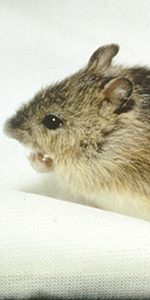| Meadow Jumping Mouse | ||
 |
Classification(s) : | Prey |
| Cat Name : | Jumping Mouse | |
| Common Name : | Meadow Jumping Mouse | |
| Scientific Name : | Zapus hudsonius | |
| Other Name(s) : | ||
| Physical Description : | Meadow jumping mice are a long-footed, long-tailed species of mouse, with a multi-colored coat that is darkest on the back and the top of the head, blends to caramel on the flanks, shoulders, and cheeks, and finishes with a white belly, chin, and paws. |
|
| Physical Statistics : | Length: 7.09-9.21 inches (180-234 millimeters) |
|
| Behavior : | Meadow jumping mice, a generally nocturnal species, are most commonly found in grassy or weedy fields, although they may also live in wooded areas if the ground cover is sufficient. They hibernate for six months of the year, and live off of seeds, nuts, berries, and insects. |
|
| Social Organization : | Meadow jumping mice tend towards the solitary, but are not generally militant towards others. |
|
| Approval Level : | None; Meadow jumping mice are widespread and their presence is not significant. | |
| Kill Difficulty : | Low; Meadow jumping mice are defenseless and quite small in comparison to a cat. |
|
| Training Level : | Advanced; Meadow jumping mice, if startled, are capable of leaps up to a meter long, followed by shorter jumps; they are also most commonly active at night. |
|
| Hunting Tactic : | Land Rodents | |
| Food Quality : | Medium; Meadow jumping mice consume a beneficial diet, but are of a rather small size. | |
